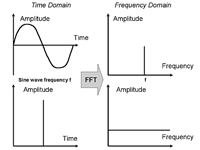FFT
FFT – Fast Fourier Transform – is a mathematical technique for converting a signal from the time domain into the frequency domain. Signals on a flaw detector, on an oscilloscope or on an acoustic emission display are typically time domain signals showing how the amplitude varies with time. When transformed into the frequency domain the display shows how the amplitude varies with the frequency. This display is often referred to as the frequency spectra of the signal. A sine wave of a single frequency in the time domain will give a single line at that frequency in the frequency domain. A spike in the time domain will give a spread of frequencies in the frequency domain. See the Figure.

The spike is made up by adding the sine waves of all the different frequencies – at one point in time they all add together to give the spike whilst at all other times they all cancel out to give zero signal. The inverse of the FFT converts back from the frequency domain to the time domain.
Fourier transforms are extremely useful because they reveal periodicities in input data as well as the relative strengths of any periodic components. As a result of the way the FFT operates, a periodic function will contain transformed peaks in not one, but two places. However, these two components are symmetric so it is only necessary to look at one to obtain frequency information. The Figure only shows one component.
As well as providing frequency information, FFT can be used to apply signal processing techniques such as the filtering of signals and the compression of images which are easier to perform in the frequency domain.
For an example of how FFTs can be used in NDT see:
'Ultrasonic detection of surface-breaking railhead defects', Edwards et al. Paper given at BINDT Annual Conference NDT 2007, Tuesday 18 September 2007 Session 1B – NDT Applications
For general information on FFTs see any good signal processing text book.
What the hec?! articles are not intended to be the definitive account on the topic or acronym in question. Readers’ comments and contributions are welcomed. Email: ndtnews@bindt.org

The spike is made up by adding the sine waves of all the different frequencies – at one point in time they all add together to give the spike whilst at all other times they all cancel out to give zero signal. The inverse of the FFT converts back from the frequency domain to the time domain.
Fourier transforms are extremely useful because they reveal periodicities in input data as well as the relative strengths of any periodic components. As a result of the way the FFT operates, a periodic function will contain transformed peaks in not one, but two places. However, these two components are symmetric so it is only necessary to look at one to obtain frequency information. The Figure only shows one component.
As well as providing frequency information, FFT can be used to apply signal processing techniques such as the filtering of signals and the compression of images which are easier to perform in the frequency domain.
For an example of how FFTs can be used in NDT see:
'Ultrasonic detection of surface-breaking railhead defects', Edwards et al. Paper given at BINDT Annual Conference NDT 2007, Tuesday 18 September 2007 Session 1B – NDT Applications
For general information on FFTs see any good signal processing text book.
What the hec?! articles are not intended to be the definitive account on the topic or acronym in question. Readers’ comments and contributions are welcomed. Email: ndtnews@bindt.org